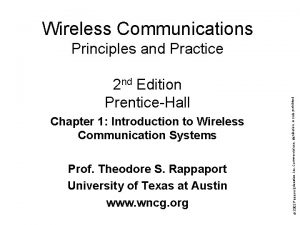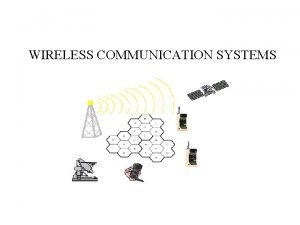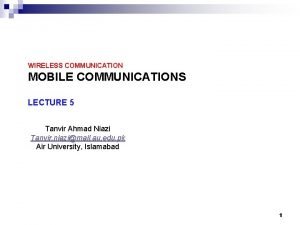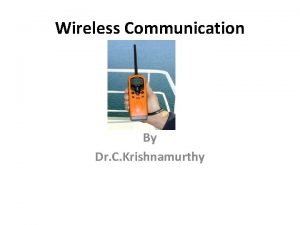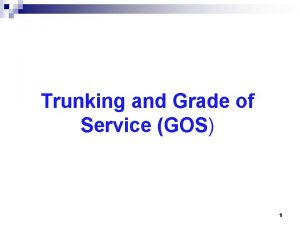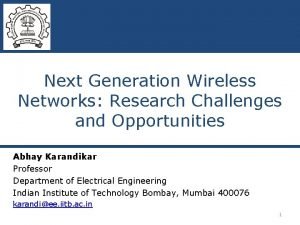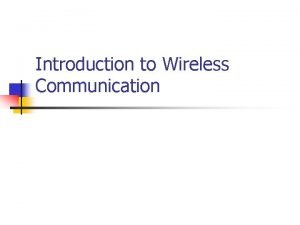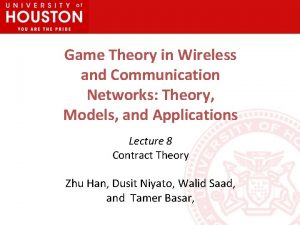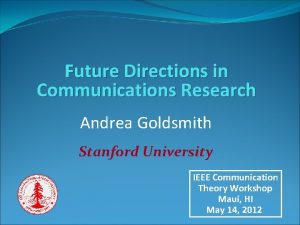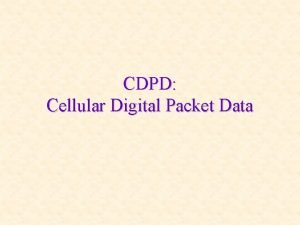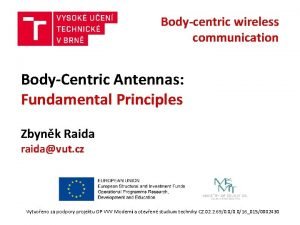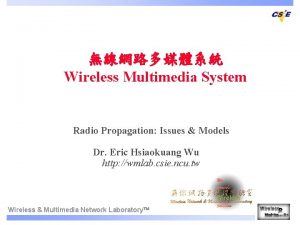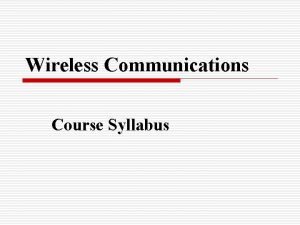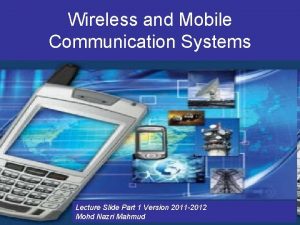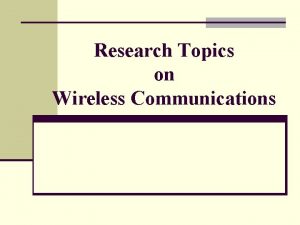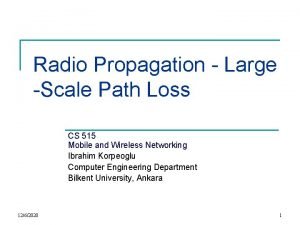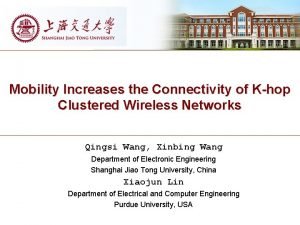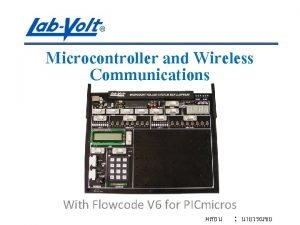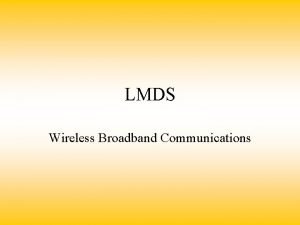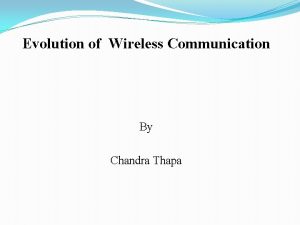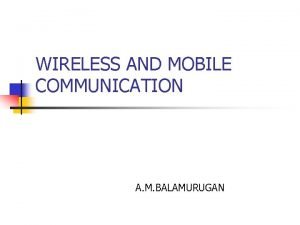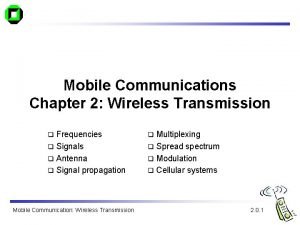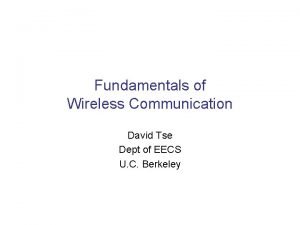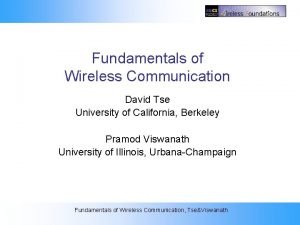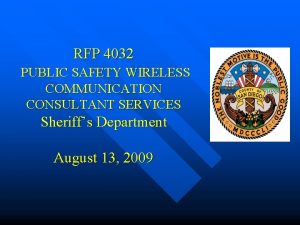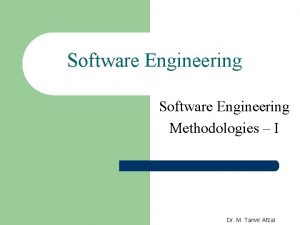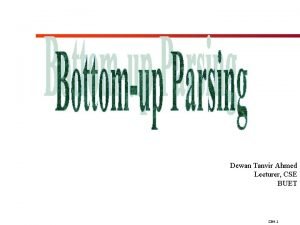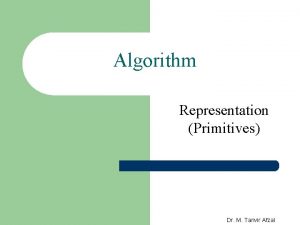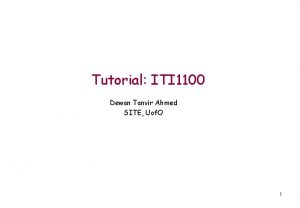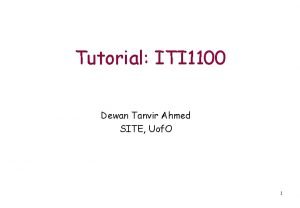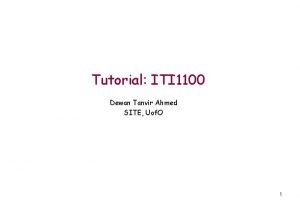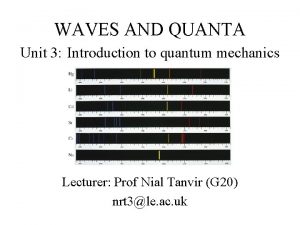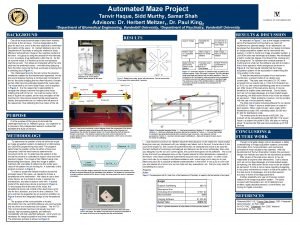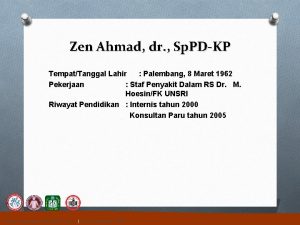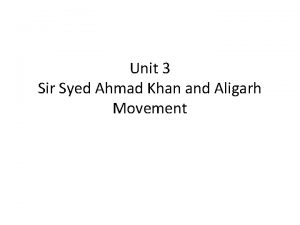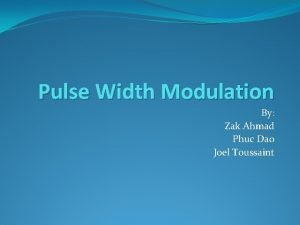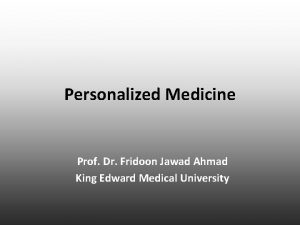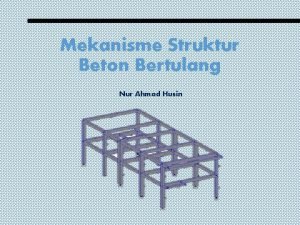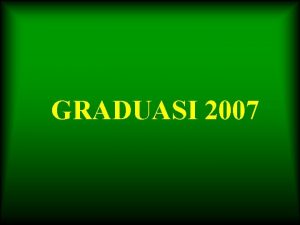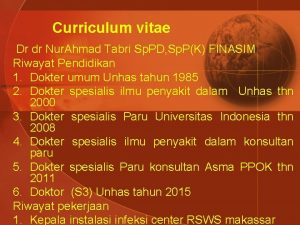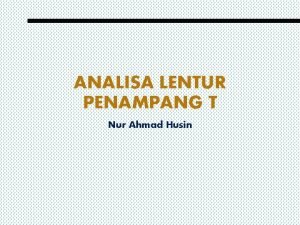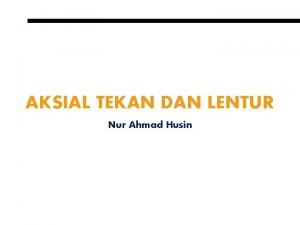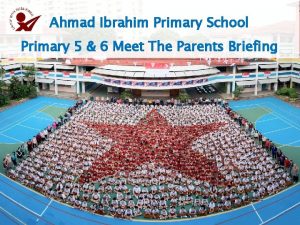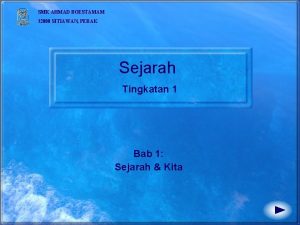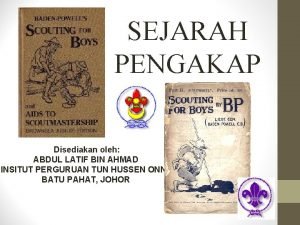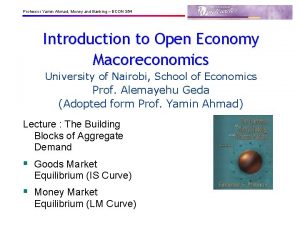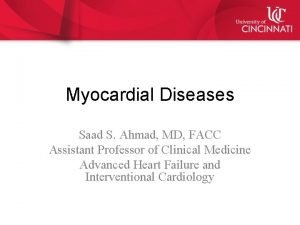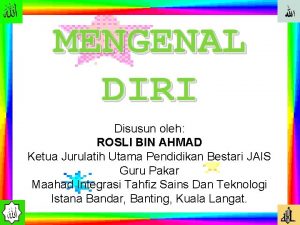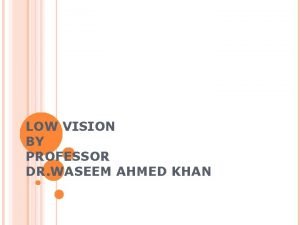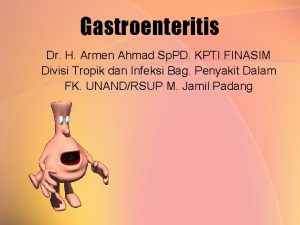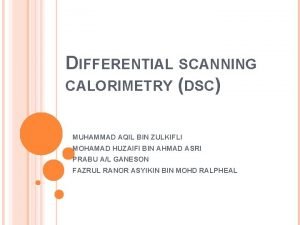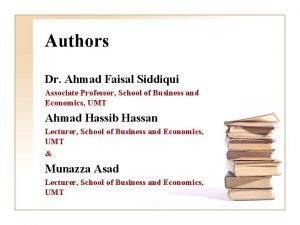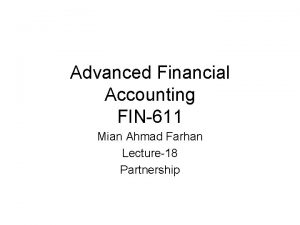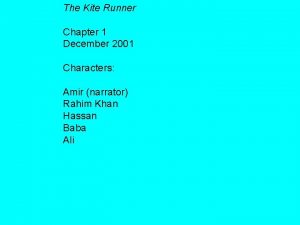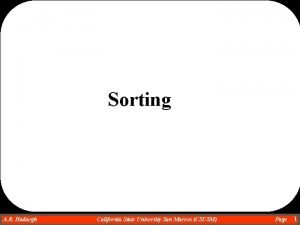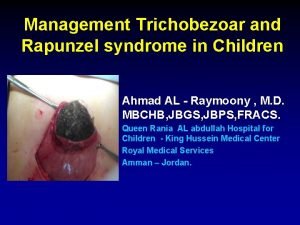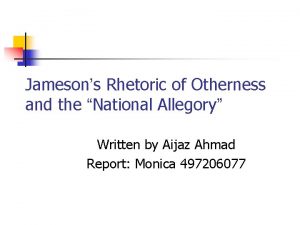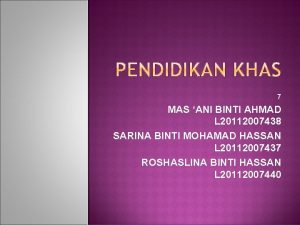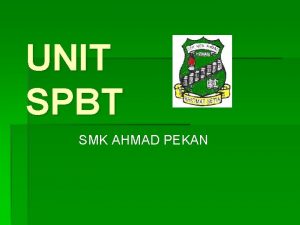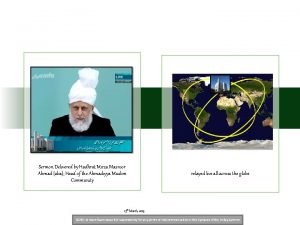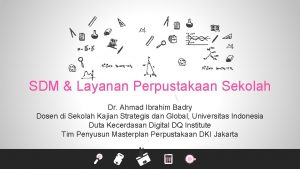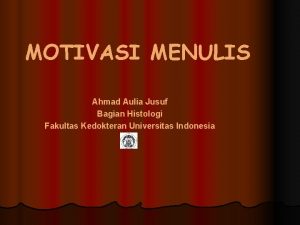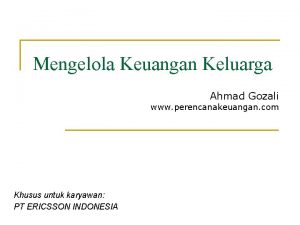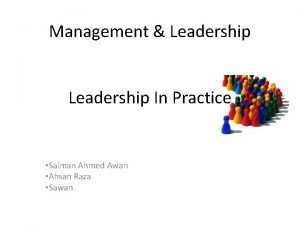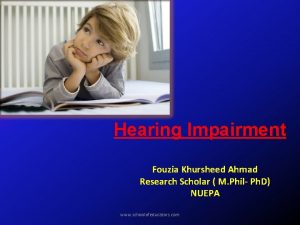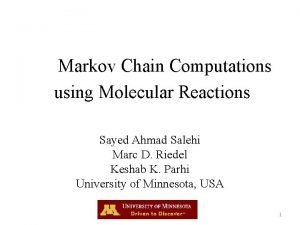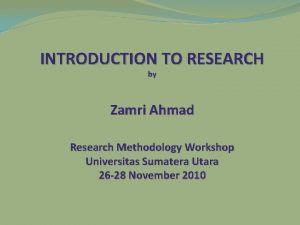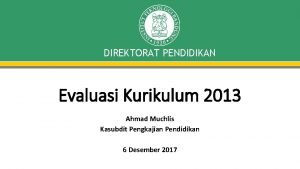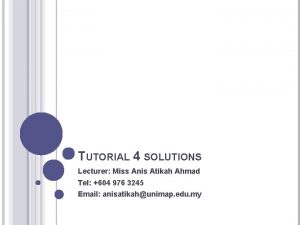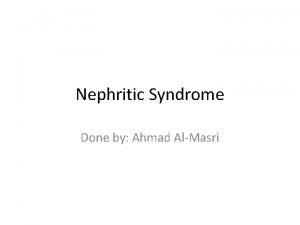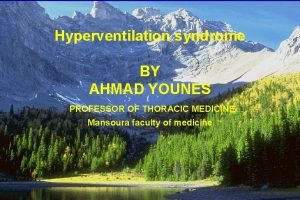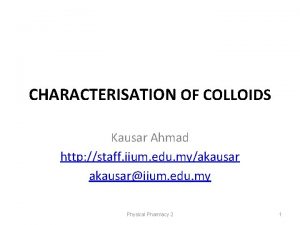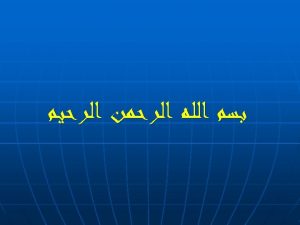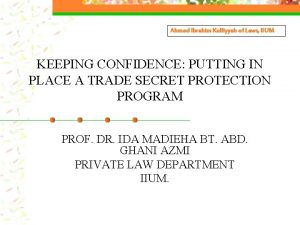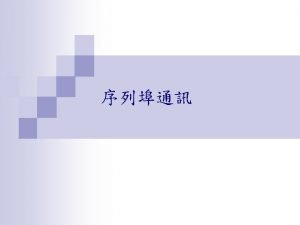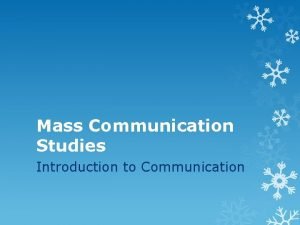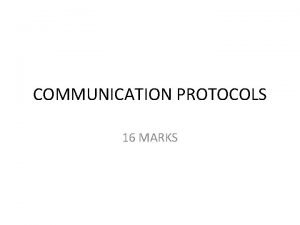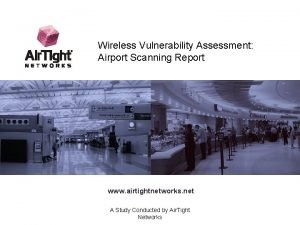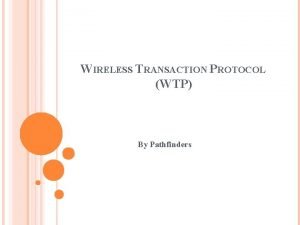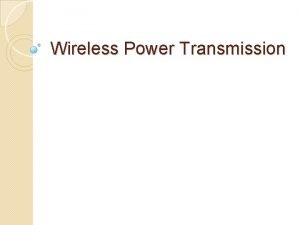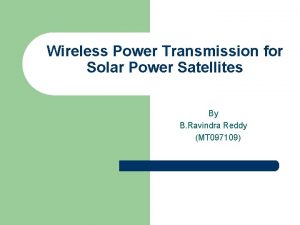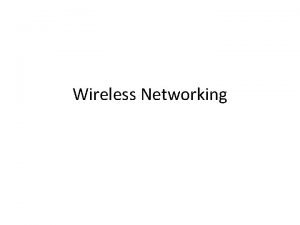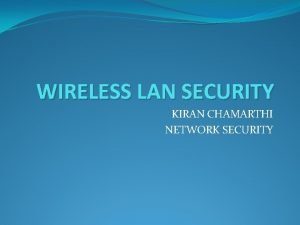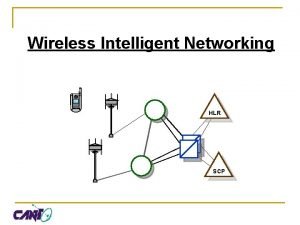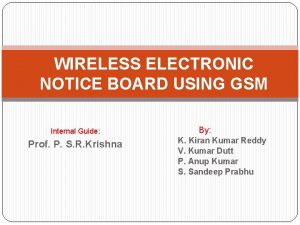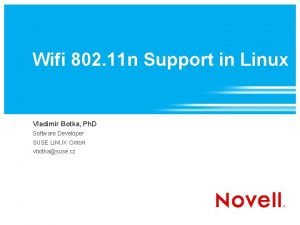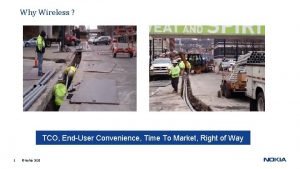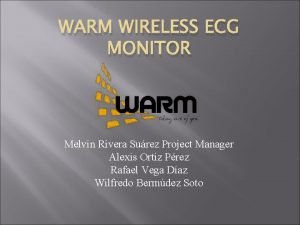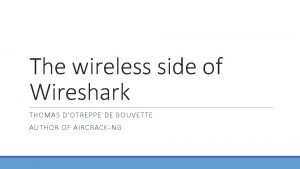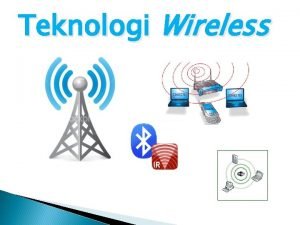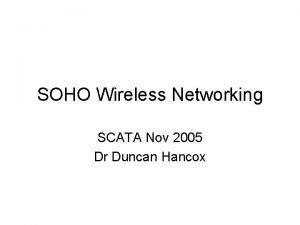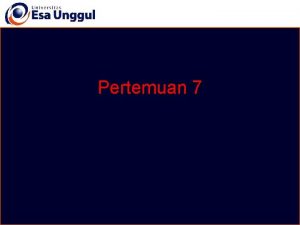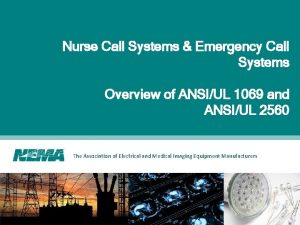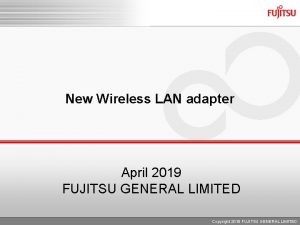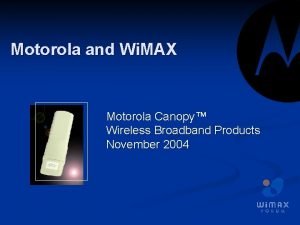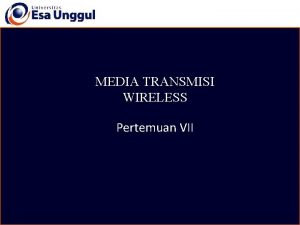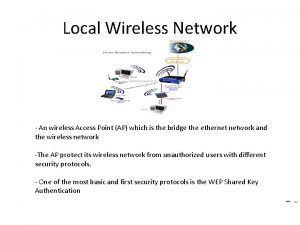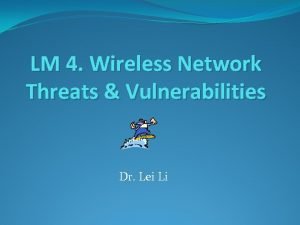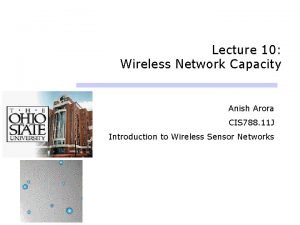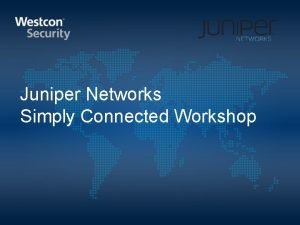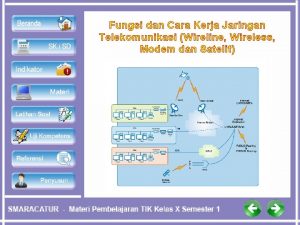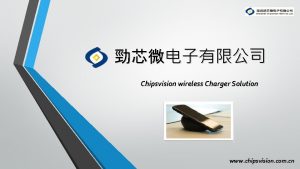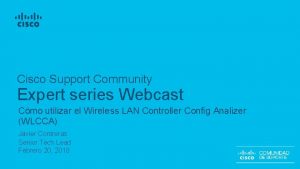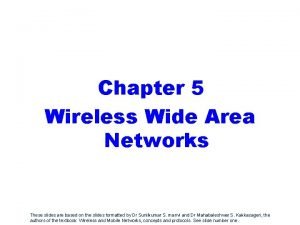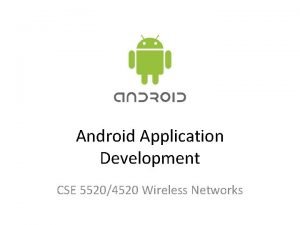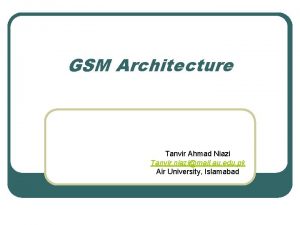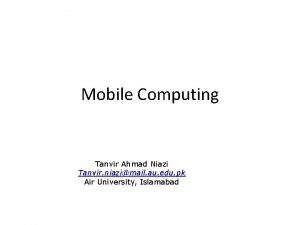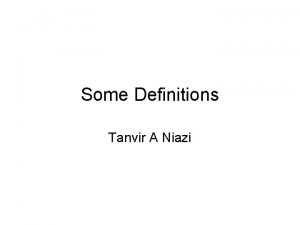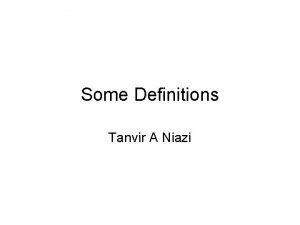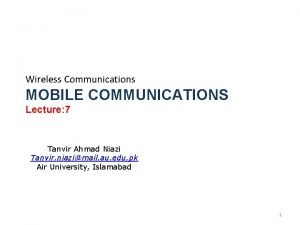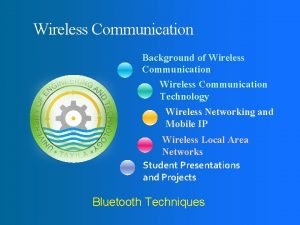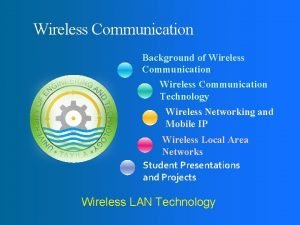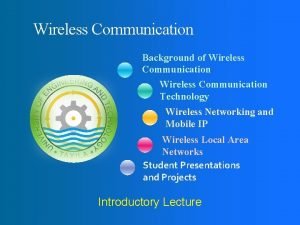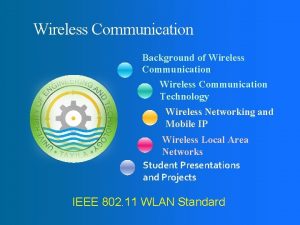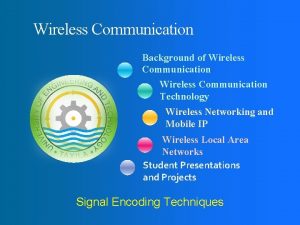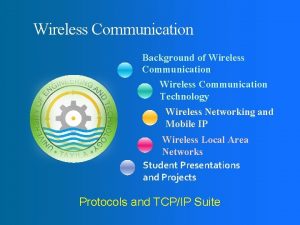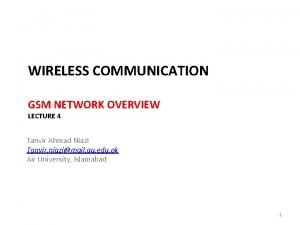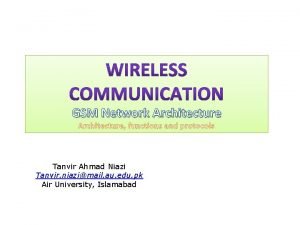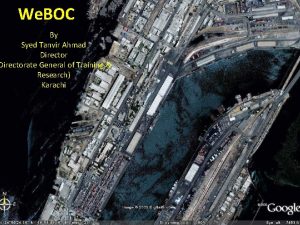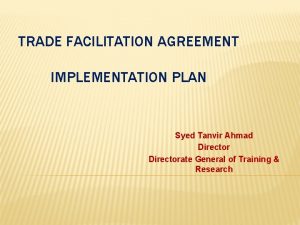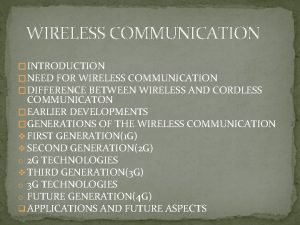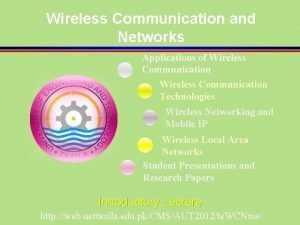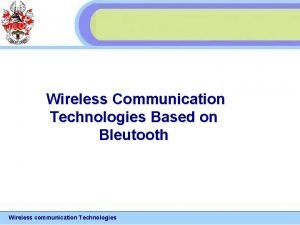WIRELESS COMMUNICATION LECTURE 3 Tanvir Ahmad Niazi Tanvir












































































































































- Slides: 140

WIRELESS COMMUNICATION LECTURE 3 Tanvir Ahmad Niazi Tanvir. niazi@mail. au. edu. pk Air University, Islamabad 1

Overview of the Previous Lecture n n Definition of Wireless and Mobile Communications Examples and Applications of Wireless Communications History and Evolution of Wireless Communications Terminology in Wireless Communication Today, we will first complete our general discussion on the cellular system, make a comparison between a fixed telephone call and a cellular call. Next, we’ll move to Chapter 3, on the Cellular Concept. 2

Cellular Telephone Systems Definition: n A Cellular telephone system provides a wireless connection to the PSTN for any user location within the radio range of the system. n High capacity is achieved by limiting the coverage of each base station transmitter to a small geographic area is called cell so that the same radio channels may be reused by another base station located some distance away. n A sophisticated switching technique called a handoff enables a call to proceed uninterrupted when the user moves from one cell to another 3

Description n Mobile Station: ¨ n Base Station: ¨ n Each Mobile Station contains a transceiver, an antenna and Control Circuitry and may be mounted in a vehicle or used as a portable hand held unit. The Base station consists of several Transmitters and receivers which simultaneously handle full duplex communications and generally have towers which support several transmitting and receiving antennas. MSC (Mobile Switching Center): ¨ The MSC coordinates the activities of all of the Base Stations and connects the entire cellular system to PSTN. 4

Basic Cellular System 5

What is Wireless Communication n n Transmitting voice and data using electromagnetic waves in open space Electromagnetic waves n n Travel at speed of light (c = 3 x 108 m/s) Has a frequency (f) and wavelength (l) § c=fxl n Higher frequency means higher energy photons n The higher the energy photon the more penetrating is the radiation 6

Electromagnetic Spectrum 104 102 100 10 -2 Radio Spectrum 10 -4 Micro wave 10 -6 IR 10 -8 UV 10 -10 10 -12 10 -14 10 -16 X-Rays Cosmic Rays 104 106 108 1010 1 MHz ==100 m 100 MHz ==1 m 10 GHz ==1 cm 1012 1014 1016 Visible light 1018 1020 1022 < 30 KHz 30 -300 KHz – 3 MHz 3 MHz – 30 MHz – 300 MHz 300 MHz – 3 GHz 3 -30 GHz > 30 GHz 1024 VLF LF MF HF VHF UHF SHF EHF 7

Wavelength of Some Technologies n GSM Phones: frequency ~= 900 Mhz ¨ wavelength ~= 33 cm ¨ n PCS Phones frequency ~= 1. 8 Ghz ¨ wavelength ~= 17. 5 cm ¨ n Bluetooth: frequency ~= 2. 4 Gz ¨ wavelength ~= 12. 5 cm ¨ 8

Frequency Carries/Channels The information from sender to receiver is carried over a well defined frequency band. n This is called a channel ¨ Each channel has a fixed frequency bandwidth (in KHz) and Capacity (bit-rate) ¨ Different frequency bands (channels) can be used to transmit information in parallel and independently ¨ 9

Example n n n Assume a spectrum of 90 KHz is allocated over a base frequency b for communication between stations A and B Assume each channel occupies 30 KHz. There are 3 channels Each channel is simplex (Transmission occurs in one way) For full duplex communication: ¨ Use two different channels (frward and reverse channels) ¨ Use time division in a channel Channel 1 (b - b+30) Station A Channel 2 (b+30 - b+60) Station B Channel 3 (b+60 - b+90) 10

Simplex Communication n Normally, on a channel, a station can transmit only in one way. n n This is called simplex transmision To enable two-way communication (called fullduplex communication) n n We can use Frequency Division Multiplexing We can use Time Division Multiplexing 11

Duplex Communication - FDD n FDD: Frequency Division Duplex Mobile Terminal M Forward Channel Reverse Channel Base Station B Forward Channel and Reverse Channel use different frequency bands 12

Duplex Communication - TDD n TDD: Time Division Duplex Mobile Terminal M M B M B Base Station B A singe frequency channel is used. The channel is divided into time slots. Mobile station and base station transmits on the time slots alternately. 13

Wireless System Definitions n Mobile Station n n A station in the cellular radio service intended for use while in motion at unspecified locations. They can be either hand-held personal units (portables) or installed on vehicles (mobiles) Base station n A fixed station in a mobile radio system used for radio communication with the mobile stations. Base stations are located at the center or edge of a coverage region. They consists of radio channels and transmitter and receiver antennas mounted on top of a tower. 14

Wireless System Definitions n Mobile Switching Center n n Subscriber n n Switching center which coordinates the routing of calls in a large service area. In a cellular radio system, the MSC connections the cellular base stations and the mobiles to the PSTN (telephone network). It is also called Mobile Telephone Switching Office (MTSO) A user who pays subscription charges for using a mobile communication system Transceiver n A device capable of simultaneously transmitting and receiving radio signals 15

Wireless System Definitions n Control Channel n n Forward Channel n n Radio channel used for transmission of call setup, call request, call initiation and other beacon and control purposes. Radio channel used for transmission of information from the base station to the mobile Reverse Channel n Radio channel used for transmission of information from mobile to base station 16

Common Air Interface 17

Base Station - Mobile Network RV C RCC FVC FCC Forward Voice Channel Reverse Voice Channel Forward Control Channel Reverse Control Channel 18

Control Channels. n Control channels are usually called as setup channels n The Channels that are responsible for initiating mobile calls and which are involved only in setting up a call and moving it to unused voice channels are called as Control Channels. They are also called as setup channels. n The two channels responsible for initiating mobile calls are Forward Control Channels (FCC) and Reverse Control Channels (RCC). n Control Channels transmit and receive data messages that carry call initiation and service requests 19

Wireless System Definitions n Simplex Systems n n Half Duplex Systems n n Communication systems which provide only one-way communication Communication Systems which allow two-way communication by using the same radio channel for both transmission and reception. At any given time, the user can either transmit or receive information. Full Duplex Systems n Communication systems which allow simultaneous two-way communication. Transmission and reception is typically on two different channels (FDD). 20

Wireless System Definitions n Handoff n n Roamer n n The process of transferring a mobile station from one channel or base station to an other. A mobile station which operates in a service area (market) other than that from which service has been subscribed. Page n A brief message which is broadcast over the entire service area, usually in simulcast fashion by many base stations at the same time. 21

Example - Frequency Spectrum Allocation in U. S. Cellular Radio Service 22

Fixed Telephone Call vs Cellular Call n n n Person A wants to call Person B who is in the same building using a conventional phone. “A” picks up the phone (off-hook), and hears the dial tone (meaning that his phone is “alive”), dials B’s number. The switch “identifies” the called party “B” and sends B the “Alert Signal”(ring), in case he was not already off-hook (busy). In the meantime, switch sends the Ring Indication to “A” meaning that your call has reached “B”. If “B” picks up his phone, switch disconnects the Ring Indication, and connects “A” with “B” and they start talking. 23

24

Schematic Diagram of Conventional Telephone System 25

n Main properties of the fixed telephone system: 1) Pair of wires connects each telephone to the switching machine. 2) Each pair of wires has its own telephone number- n Neither of these exists in a cellular system. Hence new technology is required 26

Cellular Call n n n Person C wants to call Person D, where both C and D have cellular phones. There are no wires connecting Person C’s and D’s phones to the rest of the system. Communication takes place in radio channels. The phone can tune in to a large number of channels - like a TV. Unlike a TV, however, it can also transmit. (It is a Full-Duplex System. ) Transmitted signals arrive at a Base Station (BS). Initialization: C turns on phone. It needs to establish control with BS. Each BS emits on a control channel. The phone seeks the strongest signal. It tunes to that BS and acquires information. 27

28

n Service Request: In case of cellular call, information more than a phone number is needed. C's request is relayed to a switch. n Paging The switch can establish communication with other switches. Each subscriber has a home system responsible for details of the service: billing, voice mail, etc. Let's say the same switch is the home service for both C and D. So it recognizes D's phone number as one of its own. But where is D? Paging is sent out through all the BS. 29

If person C is lucky, D has his mobile phone turned on. He responds to the control channel of the BS, and the BS informs the switch. Now the switch can set up the call. 30

Channel Assignment: Switch assigns channels to both C and D. • D's phone beeps. When he pushes a button, the beeping stops and channels are connected through the switch. • Handoff: What happens when either one changes location (BS)? The call is transferred from one BS to the other. 31

Main Points in a Cellular Call n Person C calls D using his portable cellular phone. He presses some buttons, names appear on the screen, he presses SEND when D's name shows up. D's cellular rings, he answers, they talk. n The operations associated with the two phone calls are essentially similar. The equipment involved, though, is profoundly different. n Conventional telephone: technology that evolved over 100 years. Wireless: young technology, only 20 years old. n 32

Terminologies involved in Cellular Phone Systems 1. Mobile Identification Number (MIN): Subscriber’s Telephone No. 2. Electronic Serial Number (ESN): Serial No. of the Mobile 3. Station Class Mark(SCM): It indicates the maximum Transmitter power level for a particular user. 33

Timing Diagram when a call is made by a Landline User to a Mobil 34

Timing Diagram when a call is made by a Mobile user to a Landline User 35

The Cellular Concept 1. 2. 3. Introduction Frequency Reuse Channel Assignment Strategies 36

Early Mobile Telephone Systems n n n One high-power transmitter was used to cover a large area--- approx. 50 km. Located at a very high spot. The mobiles were simultaneously connected using different Frequency channels. Capacity of such systems was very limited. 37

Basics n Early mobile telephony systems were not cellular. Coverage over a large area was provided by a high powered transmitter mounted on a tall tower. Frequency reuse was not employed. That resulted in very low capacity. n The cellular concept arose from the need to restructure the radio telephone system with the increase in demand. The increase in demand could not be satisfied just by additional spectrum allocations. n Cellular Concept: Replace large transmitters with many smaller transmitters. Neighboring base stations (BS) are assigned different sets of channels. Capacity can be increased by additional partitions. 38

n n Cell – a geographical area covered by a BS. Frequency Reuse – the frequency channels allocation scheme. For convenience, the cells are shown with a hex pattern. A hex pattern is the simplest pattern that can tessellate an area. In practice, cells are not hexagonal and BS are not exactly in the center of the cell. 39

An Example of a Cellular Cluster 40

Capacity Computations n Assume there are N cells, each allocated k different frequency channels. These N cells are said to form a cluster. Total number of channels per cluster is given by S=k. N n Total capacity associated with M clusters: C=Mk. N=MS A cluster may be replicated more times in a given area if the cells are made smaller (note that power needs to be reduced accordingly). n n Capacity of cellular system is directly proportional to “M”, number of times a cluster is replicated. 41

Capacity versus interference for same size cell n Decrease N for More Capacity: If Cluster Size, N is decreased while cell size remains fixed, more clusters are required to cover the area (M increases). Therefore, Capacity increases. n Increase N for Less Interference: On the other hand, if N is increased (large cluster size) means that co-channels are now farther than before, and hence we have will have less interference. n Value of N is a function of how much interference a mobile or a base station can tolerate. 42

Frequency Reuse 43

Frequency Reuse n Geometry of the hexagonal cells is such that to cover adjacent areas completely, N can have only some of the values. n N should satisfy the relationship, n where i and j are positive integers. Typical values of N are 4, 7, 12 etc. To draw the cell pattern given i and j: n Move i cells across hexagons. 2. Turn 60º CCW and move j cells. 1. 44

Frequency Reuse (N=7, i=2, j=1) 45

Frequency Reuse (N=19, i=3, j=2) 46

Example: A total of 33 MHz are allocated to a system which uses 2 x 25 k. Hz for full duplex (i. e. , each channel is 50 k. Hz). What is the number of channels per cell? Number of channels per system 47

Now assume 1 MHz of the 33 MHz is allocated to control channels. Each control channel is still 50 k. Hz Total number of voice (traffic) channels is now 48

Channel Assignment Strategies 49

Channel Allocation Techniques n n n To satisfy the user, a channel needs to be available on request. Reasonable probability of call blockage (GOS) is 2%. GOS fluctuate with location and time. The goal is to keep a uniform GOS across the system. Reduction of variations in GOS allow more users – an increase in capacity. Three types of algorithms for channel allocation: Fixed channel allocation (FCA) ¨ Channel Borrowing ¨ Dynamic channel allocation (DCA) ¨ 50

Fixed Channel Allocation Techniques n Available spectrum is W Hz and each channel is B Hz. Total number of channels: Nc = W/B n For a cluster size N, the number of channels per cell: Cc = Nc/N n To minimize interference, assign adjacent channels to different cells. 51

Features of Fixed Channel Allocation Techniques n n FCA is the optimum allocation strategy for uniform traffic across the cells. A non uniform FCA strategy, when it is possible to evaluate GOS in real time and adjust the FCA accordingly. This requires a more complex algorithm. 52

Channel Borrowing n n Borrow frequencies from low traffic cells to high traffic cells. Temporary channel borrowing: channel is returned after call is completed. If all the channels in a cell are occupied, channels are borrowed from neighboring cells. The MSC supervises such borrowing procedures and ensures disruption free service. 53

Dynamic Channel Allocation n All channels are placed in a pool, and are assigned to new calls according to the reuse pattern. Signal is returned to the pool, when call is completed. n Issues related to channel allocation are still under research. 54

Comparison of Channel Allocation Techniques n Fixed Channel Allocation ¨ Advantages: n n ¨ Disadvantages: n n Less load on MSC Simple Blocking may happen Dynamic Channel Allocation ¨ Advantages: n ¨ Voice channels are not allocated permanently. That is shared on need-basis Disadvantages: n n Requires MSC for processing---burden on MSC May be very complicated 55

Hand off n HANDOFF: The process of transferring a call across the cell boundaries. ¨ Handoffs are prioritized over new calls. ¨ Handoffs need to be performed infrequently. 56

Assignment # 1: Due date – 02 February, 2012 Problems: 1. 3, 1. 9, 1. 10, 1. 13, and 1. 18, 57

Overview of the Previous Lecture n n n Comparison of Fixed Telephone versus Cellular Call The Cellular Concept Frequency Reuse New Topics Channel Allocation Schemes Hand off Strategies Interference and System Capacity 58

An Example of a Cellular Cluster 59

Capacity versus interference for same size cell n Decrease N for More Capacity: If Cluster Size, N is decreased while cell size remains fixed, more clusters are required to cover the area (M increases). Therefore, Capacity increases. n Increase N for Less Interference: On the other hand, if N is increased (large cluster size) means that co-channels are now farther than before, and hence we will have less interference. n Value of N is a function of how much interference a mobile or a base station can tolerate. 60

Frequency Reuse n Geometry of the hexagonal cells is such that to cover adjacent areas completely, N can have only some of the values. n N should satisfy the relationship, n where i and j are positive integers. Typical values of N are 4, 7, 12 etc. To draw the cell pattern given i and j: n Move i cells across hexagons. 2. Turn 60º CCW and move j cells. 1. 61

Frequency Reuse (N=7, i=2, j=1) 62

Method of locating co-channel cells in a cellular system Example: N=19 i=3 j=2 63

Channel Assignment Strategies 64

Channel Allocation Techniques n n n To satisfy the user, a channel needs to be available on request. Reasonable probability of call blockage. Three types of algorithms for channel allocation: Fixed channel allocation (FCA) ¨ FCA with Channel Borrowing ¨ Dynamic channel allocation (DCA) ¨ 65

Hand Off Strategies 66

n HAND OFF: “When a mobile moves into a different cell while a conversation is in progress, MSC transfers the call to a new channel belonging to the new base station”. (Hard handoff) n In modern wireless systems, there may be no change in the actual channel; only the base station changes (Soft Hand off). n Mobile Switching Center needs to: Identify the new base station ¨ Allocate new Voice and Control channels associated with the new base station. ¨ 67

n Desired Behavior: Prioritize Hand off to new call initiation ¨ Successful transfer of call ¨ Hand off should be as infrequent as possible ¨ Hand off should be imperceptible (very slight) ¨ n Hand off Threshold Power Level: There is a minimum power level of the signal at BS for acceptable voice quality. (-90 to – 100 d. Bm). ¨ Hand off Threshold is defined D d. Bm above this level, so that the system has time to process hand off. ¨ 68

Margin D needs to be neither too small, nor too large n n n D too small too short time to perform handoff, The call may be dropped in the meanwhile. D too large unnecessary handoff burden. Hand off becomes more frequent, and occurs even when Power is at the acceptable level. Call will be dropped if 1. 2. n D is too small, Delay in MSC processing because of: High Traffic hours, New channel not available 69

Handoffs – the basics

When to Hand off? MSC needs to ensure: n When to Hand off? MSC needs to ensure: that the power drop is not temporary: because of FADING. ¨ that MS is actually moving away from the current BS. ¨ n MSC measures signal strength for some time (average received signal power). These calculations are performed to: Avoid the unnecessary hand off, ¨ Complete the necessary hand off before call drops ¨ n The time available to decide hand off depends on the subscriber’s speed. n Speed of the user can be estimated from the slope of the short term average Power. Steep curve Quick Hand off 71

First Generation Systems: n n n Signal Strength Measurements are made by base stations and supervised by MSC. Each base station constantly monitors power levels of its reverse voice channels, which tells the relative location of the user. Reverse Signal Strength Indicators: Power levels of all the calls in a cell. Locator Receiver: Power levels of Users of neighboring cells are also measured. Both these pieces of information are passed to MSC for hand off decision. In 1 G: Hand off processing takes almost 10 sec: that requires ¨ D ~= 6 -12 d. B 72

Second Generation Systems: Digital TDMA n n n Concept of Mobile Assisted Hand Off (MAHO) Mobile station continually measures power levels of surrounding Base Stations and reports these measurements to the serving Base Station. Hand off is initiated when power level from BS of neighboring cell exceeds that of the current cell, for certain time, or by a certain level MAHO method ensures faster hand off since burden of MSC is shared by Mobile Stations MAHO is particularly suited for Micro-Cellular Systems. In GSM: The time reduces to 1 -2 seconds: that needs D ~= 0 -6 d. B 73

Inter-System Hand Off n n Definition: “-----When a mobile moves from one cellular system to another, with different MSC”. The situation occurs when “Signal in the resident cell becomes weak, and no other cell within the system can take the call”. n Issues: Local Call becomes long-distance call ¨ Compatibility between two MSCs. ¨ 74

Prioritizing Hand off n n n Systems differ in methods and policies of hand off: Some systems take hand off like a new call initiation: user will be more annoyed in case of call drop than call blocking for some time. Various Methods of Prioritizing Hand off have been devised and implemented. Guard Channel Concept n n n Reserve some channels exclusively for hand off--- do not use them for call initiation. Advantage is increased probability of successful hand off. Disadvantage is lower capacity because of less number of channels for call initiation. No disadvantage in Dynamic Channel Allocation 75

Queuing of Hand off: n n Decreases the probability of forced termination of a call due to lack of available channels. Trade off between the “probability of forced termination” and “total carried traffic”. That is, “Probability of forced termination” decreases at the cost of reduced Total Carried Traffic. Queuing is possible because of the time available between the Threshold power level and the Hand off power level. Delay Time and Queue Size are related to service area. Queuing doesn’t guarantee zero probability of call drop. 76

Practical Hand Off Strategies: n n High Speed Vehicle VS Pedestrians In micro-cells for more capacity, MSC may be over-burdened in case high speed users changing the micro-cells quickly. Obtaining a new Cell Site is not always practical: Zoning, Ordinances and Laws are barrier to new cell sites. The UMBRELLA CELL Concept: Large and Small cells are co-located. Install small antennas etc for low-speed users for proper radio coverage. This guarantees large area coverage as well. 77

The Umbrella Cell Approach 78

Umbrella cell approach: n n Minimizes the number of hand offs for high speed users, Provides additional micro-cell users for pedestrians. A High speed user converting into a low speed user may be switched to smaller micro-cell by the Base Station, without MSC intervention. Speed Estimation can be performed by slope of short term average calculations of the received power, or by some more sophisticated algorithms. 79

Cell Dragging n Results from Pedestrian users who provide very strong signal to base station. n For example, in Line Of Sight (LOS) case, power does not drop to the hand off threshold level even when the user has moved deep into the neighboring cell. n Solution: Hand Off Threshold and Radio Coverage Parameters need to be adjusted. 80

Faster Hand Off Faster hand off facilitates call “rescue”, that is in need of a hand off n Hand off in modern systems is based on calculations of additional parameters including: co-channel and adjacent channel interference at Base Station or Mobile Station. n In CDMA systems: Same channel is used by all the cells. MSC decides from which BS to take the signal and pass to PSTN. (Soft Hand Off) 81

Interference and System Capacity 82

Interference n n n It is a major limiting factor in the performance of cellular radio systems. (In comparison with wired comm. Systems, the amount and sources of interferences in Wireless Systems are greater. ) Creates bottleneck in increasing capacity Sources of interference are: 1. Mobile Stations 2. Neighboring Cells 3. The same frequency cells 4. Non-cellular signals in the same spectrum n n n Interference in Voice Channels: Cross-Talk Interference in Control Channels: missed/blocked calls Urban areas usually have more interference, because of: a) Greater RF Noise Floor, b) More Number of Mobiles 83

Types 1) Co-Channel Interference (CCI) 2) Adjacent Channel Interference (ACI) 3) Other services: like a competitor cellular service in the same area (1) n n Co-Channel Interference and System Capacity The cells that use the same set of frequencies are called co-channel cells. The interference between signals from these cells is called Co-Channel Interference (CCI). Cannot be controlled by increasing RF power. Rather, this will increase CCI. Depends on minimum distance between co-channels. 84

q The yellow cells use the same set of frequency channels, and hence, interfere with each other q In the cellular system there are 6 firstlayer co-channels n n n In constant cell size and RF power, CCI is a function of Distance between the co-channel cells(D), and the size of each cell (R). Increasing ratio D/R, CCI decreases. Define Channel Reuse Ratio = Q = D/R 85

n For hexagonal geometry, D/R can be calculated: n Smaller Q provides larger capacity, since that would mean smaller N. (Capacity ∝ 1/N). Larger Q improves quality, owing to less CCI. n For N=3, N=7, N=12, N=13, Q=3, Q=4. 58, Q=6. 24 86

87

n Signal-to-interference ratio n S is the power of the signal of interest and interference. n The signal strength at distance d from a source is n That is, received signal power is inversely related to nth power of the distance. n where n = path loss exponent is the power of kth 88

n Then we can express the SIR in terms of distance n where the denominator represents the users in neighboring clusters using the same channel n �Let n Note how C/I improves with the frequency reuse N. Analog systems: U. S. AMPS required C/I ~= 18 d. B For n = 4, the reuse factor for AMPS is N ≥ 6. 49, so N = 7. Now, let us consider the worst case for a cluster size of N= 7. The mobile is at the edge of the cell. Express C/I as a function of actual distances. n n be the distance between cell centers. Then 89

Worst Case Design Worst case carrier-to-interference ratio 90

n Increasing N from 7 to 12, brings C/I above the 18 d. B level. However, the system capacity is decreased. n Reduction of capacity by 7/12 for taking care of the worst case situation when CIR ~= 17. 4 d. B is not justified because this situation will occur very rarely. n Conclusion: Co-Channel Interference controls the link performance which then decides Frequency Reuse Plan, and System Capacity. 91

92

Channel Planning for Wireless Systems n Judicious assignment of the appropriate radio channels a more difficult problem in practice. Theoretical analysis provides a guideline. n In general 5% of the available spectrum is reserved for control channels n Frequency reuse of control channels more conservative. n In CDMA N=1, however, practical difficulties forces some kind of frequency planning. 93

Adjacent Channel Interference n n n Interference from channels that are adjacent in frequency, The primary reason for that is Imperfect Receive Filters which cause the adjacent channel energy to leak into your spectrum. Problem is severer if the user of adjacent channel is in close proximity. Near-Far Effect n Near-Far Effect: The other transmitter(who may or may not be of the same type) captures the receiver of the subscriber. n Also, when a Mobile Station close to the Base Station transmits on a channel close to the one being used by a weaker mobile: The BS faces difficulty in discriminating the desired mobile user from the “bleed over” of the adjacent channel mobile. 94

Near-Far Effect: Case 1 n The Mobile receiver is captured by the unintended, unknown transmitter, instead of the desired base station 95

Near-Far Effect: Case 2 n The Base Station faces difficulty in recognizing the actual mobile user, when the adjacent channel bleed over is too high. 96

Minimization of ACI (1) Careful Filtering ---- min. leakage or sharp transition (2) Better Channel Assignment Strategy n n Channels in a cell need not be adjacent: For channels within a cell, Keep frequency separation as large as possible. Sequentially assigning cells the successive frequency channels. Also, secondary level of interference can be reduced by not assigning adjacent channels to neighboring cells. For tolerable ACI, we either need to increase the frequency separation or reduce the passband BW. 97

Example 2. 3 n n n In the US APMS system the total number of channels is: 416 Out if these 395 are used as voice channels, whereas 21 are used a control channels. Two operators share these 416 channels eqyally. Channel allocation according to Table 3. 2 (next slide). Using subsets i. A+ For N=7, each cell in a cluster will have 1 control channel, neighboring clusters will have remaining 14 control channels. Control channels will be thus be reused according to N=21 pattern. 98

99

Power Control for Reducing Interference n n Power levels transmitted by every subscriber unit are under constant control by the Base Station. Mobile Station should transmit minimum power to maintain quality link on reverse channel. This has benefits of longer Battery Life at the Mobile Station Reduced reverse SIR. In CDMA systems, it is extremely important to control the power, as the neighboring cells are using the same channel. 100

Trunking and Grade of Service (GOS) 101

Trunking and Grade of Service (GOS) Trunking: n n A means for providing access to users on demand from available pool of channels. With trunking, a small number of channels can accommodate large number of random users. n n Telephone companies use trunking theory to determine number of circuits required. Trunking theory is about how a population can be handled by a limited number of servers. 102

Terminology: 1. Traffic intensity is measured in Erlangs: ¨ 2. 3. 4. One Erlang: traffic in a channel completely occupied. 0. 5 Erlang: channel occupied 30 minutes in an hour. Grade of Service (GOS): probability that a call is blocked (or delayed). Set-Up Time: time to allocate a channel. Blocked Call: Call that cannot be completed at time of request due to congestion. Also referred to as Lost Call. 5. 6. 7. Holding Time: (H) average duration of typical call. Load: Traffic intensity across the whole system. Request Rate: (λ) average number of call requests per unit time. 103

Traffic Measurement (Erlangs) 104

105

Tahir Iqbal, Air University 106

107

108

109

110

111

Erlang C Model –Blocked calls cleared n A different type of trunked system queues blocked calls –Blocked Calls Delayed. This is known as an Erlang C model. n Procedure: Determine Pr[delay> 0] = probability of a delay from the chart. ¨ Pr[delay � > t | delay �> 0 ] = probability that the delay is longer than t, given that there is a delay Pr[delay �> t | delay �> 0 ] =exp[-(C-A)t /H ] ¨ Unconditional Probability of delay �> t : Pr[delay �> t ] = Pr[delay �> 0] Pr[delay �> t | delay �> 0 ] ¨ Average delay time D = Pr[delay� > 0] H/ (C-A) ¨ 112

Erlang C Formula n The likelihood of a call not having immediate access to a channel is determined by Erlang C formula: 113

Tahir Iqbal, Air University 114

115

116

Improving Capacity in Cellular Systems n n Cost of a cellular network is proportional to the number of Base Stations. The income is proportional to the number of users. Ways to increase capacity: New spectrum –expensive. PCS bands were sold for $20 B. ¨ Architectural approaches: cell splitting, cell sectoring, reuse partitioning, microcell zones. ¨ Dynamic allocation of channels according to load in the cell (non-uniform distribution of channels). ¨ Improve access technologies. 3. 7 Improving Capacity in Cellular Systems ¨ 117

Cell Splitting n Cell Splitting is the process of subdividing the congested cell into smaller cells (microcells), Each with its own base station and a corresponding reduction in antenna height and transmitter power. n Cell Splitting increases the capacity since it increases the number of times the channels are reused. 118

An Example n n The area covered by a circle with radius R is four times the area covered by the circle with radius R/2 The number of cells is increased four times The number of clusters the number of channels and the capacity in the coverage area are increased Cell Splitting does not change the co-channel re-use ratio Q =D/R 119

Transmit Power n n n New cells are smaller, so the transmit power of the new cells must be reduced How to determine the transmit power? The transmit power of the new cells can be found by examining the received power at the new and old cell boundaries and setting them equal n Pr(at the old cell boundary) is proportional to n Pr(at the new cell boundary) is proportional to 120

Transmit Power 121

Application of cell splitting n n n Not all cells are split at the same time. Larger transmit power Some of the channels would not be sufficiently separated from the cochannel cells. Smaller transmit power --parts of the larger cells left uncovered Two groups: ¨ one that corresponds to the smaller cell and the other for larger cell reuse requirements 122

Application of cell splitting (cont. ) n n The sizes of these two groups depend on the stage of the splitting process At the beginning, fewer channels will be there in the smaller power group. As the demand grows, smaller groups would require more channels Cell splitting continues until all the channels are in the smaller power group Antenna Down tilting ¨ To limit the radio coverage of microcells 123

Cell Overlay n n It’s a relatively novel technique Cells used by A are divided into: ¨ Channels used by ‘a’ –those are used by ‘A’ only within radius R/2 from center. ¨ Channels not used by ‘a’ –no restrictions on their use in A. 124

Cell sectoring n Another way to reduce the number of cells in a cluster and hence, to reduce Interference is sectoring. Sectoring refers to the use of directional rather than omni antennas. Three (3) 120 degrees sectors are shown as an example n Analysis: mobile in center cell will experience interference from only 2 cells (not 6). Improvement of 6 d. B in S/I. Alternatively, try to reduce the reuse factor. Sectoring entails reduced trunking efficiency. 125

126

Tahir Iqbal, Air University 127

Example of Cell Sectoring n With omin directional antennas n Where we assumed that the power attenuation n = 4. For N = 4, we obtain S = 13. 8 d. B. For N = 4 and with 3 sectors, we get S = 19. 9 d. B: n 128

Microzones n n n Multiple zones and a base station make up a cell As a mobile travels within the cell, it is served by the zone with the strongest signal This technique is superior to sectoring because antennas are placed at the outer edges of the cell, and any base station channel can be assigned to any zone by the base station 129

Microzoning 130

ADVANTAGES n No handoffs is required at the MSC n The base station radiation is localized and interference is reduced. A given channel is active only in the particular zone in which the mobile is traveling n The co-channel interference is also reduced 131

n Decreased co-channel interference improves signal quality which leads to an increase in capacity without any degradation in trunking efficiency caused by sectoring n For example We know an (S/I) of 18 d. B is required for satisfactory system performance in narrowband FM 132

EXAMPLE n n n If a system with N=7 and (D/R)=4. 6, it can achieved a (S/I) of 18 d. B For a microcell zone system, since transmission at any instant is confined to a particular zone, this implies that a (Dz/Rz) of 4. 6 can achieve the required performance where, Dz = minimum distance between active co-channel zones and Rz = zone radius 133

134

EXAMPLE (cont. ) 135

136

Repeaters for Range Extension n Repeaters are radio re-transmitters used to provide coverage for hard-toreach areas, such as within buildings or in valleys or tunnels n Repeaters are bidirectional. Upon receiving signals from base station, then amplifies and reradiates the base station signals to the specific coverage region. Also it will send signals to the serving base station. n The repeaters do not add capacity to the system-it simply serves to reradiate the base station signal into specific locations 137

Repeaters for Range Extension 138

Summary for chapter 3 n Concepts of handoff, frequency reuse, trunking efficiency and frequency planning have been presented n The capacity of a cellular system depends on several factors and the methods to increase the capacity n The overriding objective of these methods is to increase the number of users in the system 139

Announcements Problems: 1. 3, 1. 13, 1. 9, 1. 10 and 1. 18 n Problems: 3. 1, 3. 2, 3. 4, 3. 5 and 3. 8 n Due date 14 th March, 2008 140
 Scope of environmental audit
Scope of environmental audit Usman niazi nhs
Usman niazi nhs Khusrow niazi
Khusrow niazi Telecommunications the internet and wireless technology
Telecommunications the internet and wireless technology 01:640:244 lecture notes - lecture 15: plat, idah, farad
01:640:244 lecture notes - lecture 15: plat, idah, farad Wireless communication introduction
Wireless communication introduction System 1 evolution
System 1 evolution Cell dragging in wireless communication
Cell dragging in wireless communication Advantages of wireless communication
Advantages of wireless communication Trunking and grade of service
Trunking and grade of service Next generation wireless communication market
Next generation wireless communication market Disadvantage of wireless communication
Disadvantage of wireless communication Game theory in wireless and communication networks
Game theory in wireless and communication networks Andrea goldsmith stanford
Andrea goldsmith stanford Cellular digital packet data
Cellular digital packet data Fundamental principles of wireless communication
Fundamental principles of wireless communication Free space propagation model in wireless communication
Free space propagation model in wireless communication Wireless communication course syllabus
Wireless communication course syllabus Large scale fading in wireless communication
Large scale fading in wireless communication Wireless communication research topics
Wireless communication research topics (y+z)p+(z+x)q=x+y
(y+z)p+(z+x)q=x+y Free space propagation model in wireless communication
Free space propagation model in wireless communication Flowcode programming
Flowcode programming Lmds in wireless communication
Lmds in wireless communication Evolution of wireless communication
Evolution of wireless communication Mobile and wireless communication syllabus
Mobile and wireless communication syllabus Wireless communication
Wireless communication David tse fundamentals of wireless communication
David tse fundamentals of wireless communication Fundamental of wireless communication
Fundamental of wireless communication Trunking efficiency in wireless communication
Trunking efficiency in wireless communication Wireless communication consultant
Wireless communication consultant Emdadul haque milon
Emdadul haque milon Dr. m. tanvir afzal
Dr. m. tanvir afzal Dewan tanvir ahmed
Dewan tanvir ahmed Dr. m. tanvir afzal
Dr. m. tanvir afzal Dr. m. tanvir afzal
Dr. m. tanvir afzal Dewan tanvir ahmed
Dewan tanvir ahmed Dewan tanvir ahmed
Dewan tanvir ahmed Iti 1100
Iti 1100 Dr tanveer afzal
Dr tanveer afzal Nial tanvir
Nial tanvir Md emdadul hoque tanvir
Md emdadul hoque tanvir Dr. m. tanvir afzal
Dr. m. tanvir afzal Crisis communication lecture
Crisis communication lecture Business communication lecture slides
Business communication lecture slides Metorph
Metorph Aligarh movement
Aligarh movement Phuc dao
Phuc dao Dr fawad ahmad randhawa
Dr fawad ahmad randhawa Fridoon
Fridoon Nur ahmad husin
Nur ahmad husin Ain syafinaz mohd razip
Ain syafinaz mohd razip What is the difference between neurosis and psychosis
What is the difference between neurosis and psychosis Seitz filter funnel
Seitz filter funnel Dr nur ahmad tabri
Dr nur ahmad tabri Nur ahmad husin
Nur ahmad husin Nur ahmad husin
Nur ahmad husin Ibrahim primary school
Ibrahim primary school Ahmad boestamam sejarah tingkatan 4
Ahmad boestamam sejarah tingkatan 4 Kata kata terakhir pengasas pengakap sebelum meninggal
Kata kata terakhir pengasas pengakap sebelum meninggal Yamin ahmad
Yamin ahmad Hadi ahmad md
Hadi ahmad md Kussmaul sign
Kussmaul sign Rosli bin ahmad
Rosli bin ahmad Waseem ahmad khan
Waseem ahmad khan Dr armen ahmad
Dr armen ahmad Ahmad rafiki
Ahmad rafiki Power compensated dsc
Power compensated dsc Ahmad rafay alam
Ahmad rafay alam Dr basith ali siddiqui
Dr basith ali siddiqui Mian ahmad farhan
Mian ahmad farhan Rabiah ahmad
Rabiah ahmad Sharif kite runner
Sharif kite runner Ahmad hadaegh
Ahmad hadaegh Dr shahzad ahmad
Dr shahzad ahmad National allegory examples
National allegory examples Dr ani binti ahmad
Dr ani binti ahmad Inovasi spbt
Inovasi spbt Ahmad aulia jusuf
Ahmad aulia jusuf Dr mirza ahmad
Dr mirza ahmad Kompetensi manajerial kepala perpustakaan
Kompetensi manajerial kepala perpustakaan Nephrotic syndrome
Nephrotic syndrome Ahmad aulia jusuf
Ahmad aulia jusuf Pasti
Pasti Autocratic leadership
Autocratic leadership Google scholarm
Google scholarm 7 stars doctor fkui
7 stars doctor fkui He said hurrah we have won the match
He said hurrah we have won the match Sipnosis
Sipnosis Ahmad makki hasan
Ahmad makki hasan Sayed ahmad salehi
Sayed ahmad salehi Zamri ahmad
Zamri ahmad Ahmad kamal
Ahmad kamal Dr. ahmad muchlis
Dr. ahmad muchlis Atikah ahmad
Atikah ahmad Compensated shock
Compensated shock Nephrtic syndrome
Nephrtic syndrome Hyperventilation treatment
Hyperventilation treatment Kausar ahmad
Kausar ahmad Dr adnan ahmad
Dr adnan ahmad Ahmad ibrahim kulliyyah of laws
Ahmad ibrahim kulliyyah of laws Parallel and serial port
Parallel and serial port What is oral communication and written communication
What is oral communication and written communication Parallel and serial communication difference
Parallel and serial communication difference Types of nonverbal communication chronemics
Types of nonverbal communication chronemics What is oral communication and written communication
What is oral communication and written communication Serial communication vs parallel communication
Serial communication vs parallel communication Waites sensor technologies
Waites sensor technologies Wireless vulnerability assessment
Wireless vulnerability assessment Tr-invoke
Tr-invoke Air ionization in wireless power transmission
Air ionization in wireless power transmission Wireless power transmission project report doc
Wireless power transmission project report doc Wireless network definition
Wireless network definition Wlan network
Wlan network Scp wike
Scp wike Wireless guest access solution
Wireless guest access solution Wireless electronic notice board using gsm
Wireless electronic notice board using gsm Replace crda with core/wireless-regdb?
Replace crda with core/wireless-regdb? Wireless presentation tco
Wireless presentation tco Melvin rivera
Melvin rivera Thomas d'otreppe de bouvette
Thomas d'otreppe de bouvette Apakah artinya
Apakah artinya Wireless geolocation system
Wireless geolocation system Soho router definition
Soho router definition Wml language
Wml language Nurse call systems comparison
Nurse call systems comparison Fujitsu general wifi adapter
Fujitsu general wifi adapter Wireless security in cryptography
Wireless security in cryptography Motorola
Motorola Media transmisi wireless
Media transmisi wireless Local wireless networks
Local wireless networks Wireless security threats and vulnerabilities
Wireless security threats and vulnerabilities Wireless network capacity
Wireless network capacity Juniper wlm series wireless lan managers
Juniper wlm series wireless lan managers Wireless sensor network protocols
Wireless sensor network protocols Toast pos network requirements
Toast pos network requirements Wireline wireless
Wireline wireless Wireless charger cvs
Wireless charger cvs Wlcca
Wlcca Wireless wide area networks
Wireless wide area networks Android wireless application development
Android wireless application development





